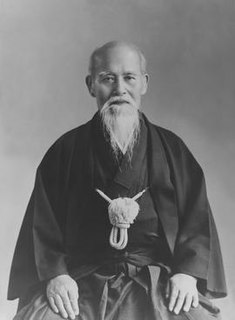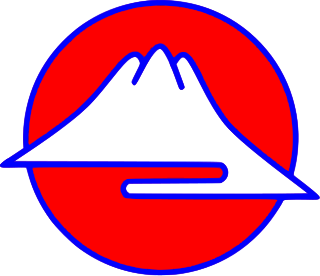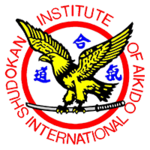
Aikido is a modern Japanese martial art that is split into many different styles, including Iwama Ryu, Iwama Shin Shin Aiki Shuren Kai, Shodokan Aikido, Yoshinkan, Renshinkai, Aikikai and Ki Aikido. Aikido is now practiced in around 140 countries. It was originally developed by Morihei Ueshiba, as a synthesis of his martial studies, philosophy and religious beliefs. Ueshiba's goal was to create an art that practitioners could use to defend themselves while also protecting their attackers from injury. Aikido is often translated as "the way of unifying (with) life energy" or as "the way of harmonious spirit". According to the founder's philosophy, the primary goal in the practice of aikido is to overcome oneself instead of cultivating violence or aggressiveness. Morihei Ueshiba used the phrase masakatsu agatsu katsuhayabi" to refer to this principle.

Morihei Ueshiba was a Japanese martial artist and founder of the martial art of aikido. He is often referred to as "the founder" Kaiso (開祖) or Ōsensei (大先生/翁先生), "Great Teacher".

Daitō-ryū Aiki-jūjutsu, originally called Daitō-ryū Jujutsu, is a Japanese martial art that first became widely known in the early 20th century under the headmastership of Takeda Sōkaku. Takeda had extensive training in several martial arts and referred to the style he taught as "Daitō-ryū". Although the school's traditions claim to extend back centuries in Japanese history there are no known extant records regarding the ryū before Takeda. Whether Takeda is regarded as either the restorer or the founder of the art, the known history of Daitō-ryū begins with him. Takeda's best-known student was Morihei Ueshiba, the founder of Aikido.
In Japanese martial arts, Irimi (入り身) is the act of entering straight into a technique, as opposed to the more indirect entrance into technique called tenkan. In basic training, irimi usually looks like a step forward, straight or at an angle but usually ending with the body facing the attacker, rather than in the direction of the step. To enter with irimi, the defender needs to move in the very moment of the attack or even himself initiate it.
YoshinkanAikido is a style of aikido that developed after World War II in the Yoshinkan Dojo of Gozo Shioda (1915–1994). Yoshinkan Aikido is often called the "hard" style of aikido because the training methods are a product of Shioda's grueling life before the war. Shioda named his dojo "Yoshinkan" after a dojo of the same name that was built by his father, a physician, who wanted to improve both physical and spiritual health. The Yoshinkan style is currently the second largest aikido organization worldwide.

Koichi Tohei was a 10th Dan aikidoka and founder of the Ki Society and its style of aikido, officially Shin Shin Toitsu Aikido, but commonly known as Ki-Aikido.
Gozo Shioda was a Japanese master of aikido who founded the Yoshinkan style of aikido. He was one of aikido founder Morihei Ueshiba's most senior students. Shioda held the rank of 10th dan in aikido.
Kenji Tomiki was a Japanese martial artist who specialized in aikido and judo family of martial arts. He was a pedagogue of martial arts theory. He is the founder of Japan Aikido Association and the competitive aikido style.

Minoru Mochizuki was a Japanese martial artist who founded the dojo Yoseikan. He was a 10th dan in Aikido, 9th dan in jujutsu, 8th dan in iaido, 8th dan in judo, 8th dan in kobudo, 5th dan in kendo, 5th dan in karate, and a 5th dan in jojutsu.
Ljubomir Vračarević, was a Serbian martial artist and founder of Real Aikido.

Yoseikan Aikido is the aikido taught at the Yoseikan Dojo in Shizuoka, Japan, under the direction of Minoru Mochizuki.
Though the art of aikido is characteristically different from other Japanese martial arts, it has a variety of identifiable styles within the family of organizations descending from the teachings of Morihei Ueshiba.
Yasuhisa Shioda is the third Sōke of Yoshinkan aikido, succeeding his brother, Tetsutaro Shioda, in keeping with the iemoto tradition in Japanese martial arts. Their father, Gozo Shioda, founded Yoshinkan aikido. He was Kancho of the headquarters dojo in Shinjuku, Tokyo and headed both the All Japan Yoshinkan Aikido Federation and the International Yoshinkai Aikido Federation until he left the organization in 2012. In 2014 he founded the SIAF together with his son Masahiro Shioda.
Kiyoyuki Terada was a Japanese aikido teacher. He was ranked 10th dan in Yoshinkan Aikido and served as the most senior instructor in Yoshinkan Aikido until his death.

Joseph 'Joe' Haridas Thambu is a teacher of Yoshinkan Aikido, currently ranked 8th Dan, Shihan.

Kyoichi Inoue was a 10th dan Yoshinkan aikido master. He was an uchideshi under Yoshinkan founder Gozo Shioda, in what became the Yoshinkan senshusei course. During his early years as an uchi-deshi, he was instrumental in developing the Yoshinkan's current pedagogical system along with Takashi Kushida in consultation with Gozo Shioda.
Munenori Kawai (1931-2010) was an 8th dan aikido practitioner and acupuncturist, who held the roles of President of the South American Aikido Federation and Vice-President of the International Aikido Federation. He was responsible for the introduction of aikido to Brazil in 1963.

Robert Mustard is a teacher of Yoshinkan Aikido. He is currently ranked 8th Dan, Shihan.

David G Dangerfield is one of Australia's senior professional Budo instructors.

Jacques Payet is a practitioner of Yoshinkan-style aikido. He was the longest-serving non-Japanese uchi-deshi of Yoshinkan founder Gozo Shioda and is ranked Hachidan in the Yoshinkan organization, with the honorific Shihan. He is the founder and head instructor of Mugenjuku dojo and the Mugenjuku Kenshusei program in Kyoto, Japan. He is also the originator of the well-known Senshusei Course, a translator of several important works in aikido, and a guest instructor in demand around the world.











